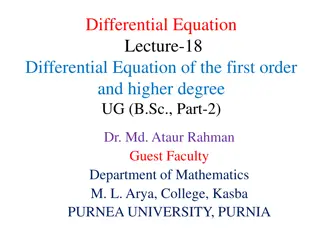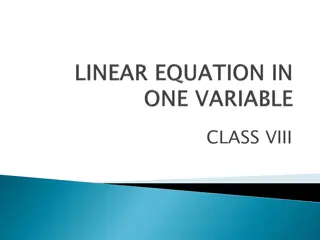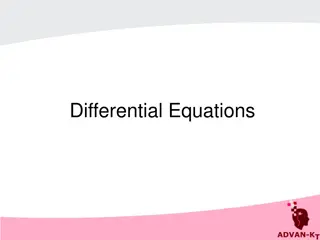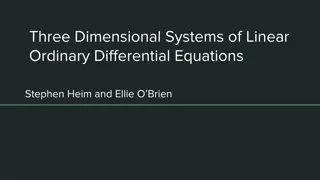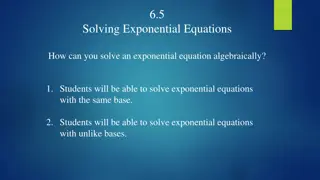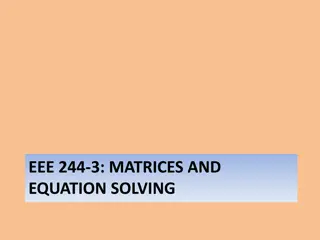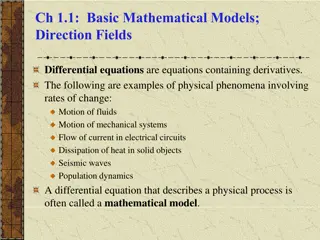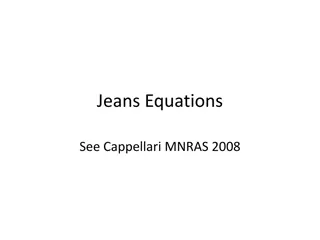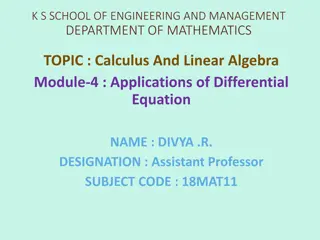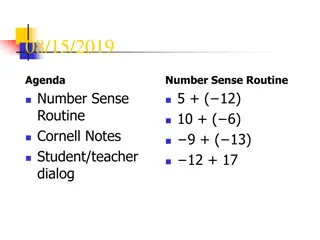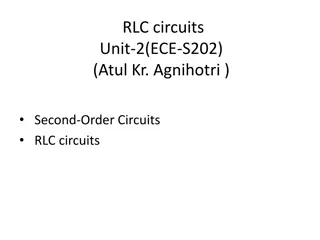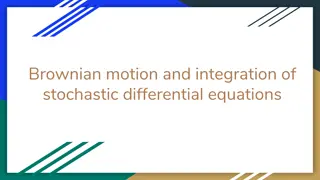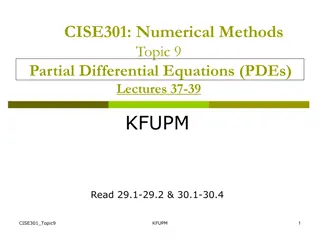Understanding Differential Equations: Basics to Applications
Differential equations are fundamental in mathematics, with various types such as first-order, partial, and Clairaut's equations explored in this content. The content covers general equations, solutions, and examples, providing insights into linear and higher-order equations with constant coefficients.
Download Presentation

Please find below an Image/Link to download the presentation.
The content on the website is provided AS IS for your information and personal use only. It may not be sold, licensed, or shared on other websites without obtaining consent from the author. Download presentation by click this link. If you encounter any issues during the download, it is possible that the publisher has removed the file from their server.
E N D
Presentation Transcript
UNIT I UNIT II UNIT -III
The general first order equation of degree n is an equation of the form 1) a0(x, y)(y')n+ a1(x, y)(y')n -1+ .... + an-1(x, y)y' + an(x, y) = 0 or, equivalently, 2) a0(x, y) pn+ a1(x, y)pn -1+ .... + an-1(x, y)p + an(x, y) = 0 where in 2) we have used the usual convention of denoting y' by the letter p. Examples.The following equations are of the first order and varying degrees: xy (y')2+ (x2+ xy + y2)y' + x2+ xy = 0 (x2+ 1)(y')4+ (x + 3 y)(y')2+ 2x2+ y = 0 (xy + 2)(y')3+ (y')2+ 5x2= 0 degree 2 degree 4 degree 3
Equations solvable for p.Here the left member of 2), viewed as a polynomial in p, can be resolved into n linear real factors i.e. 2) can be put into the form (p - F1)(p - F2) ...... (p - Fn) = 0 where the F s are functions of x and y. Procedure.Factor into n linear real factors, set each factor equal to zero and solve the resulting n differential equations of the first order and first degree dy/dx = f1(x, y,) dy/dx = f2(x, y,) dy/dx = fn(x, y,) to obtain 3) C) = 0 The primitive of 2) is the product f1(x, y, C) f1(x, y, C) .................. f1(x, y, C) = 0 of the n solutions 3). f1(x, y, C) = 0, f2(x, y, C) = 0, .......... , fn(x, y,
Example. Solve xy (y')2+ (x2+ xy + y2)y' + x2+ xy = 0 Solution. In terms of p this equation is xy p2+ (x2+ xy + y2)p + x2+ xy = 0 and factored as (xp + x + y)(yp + x) = 0 The solutions of the component equations x dy/dx +x+y =0 and y dy/dx +x =0 are respectively 2xy + x2- C = 0 The primitive is (2xy + x2- C )(x2+ y2- C) = 0 x2+ y2- C = 0 and
Clairauts equation. The differential equation y = px + f(p) is called Clairaut s equation. Its primitive is y = Cx + f(C) and is obtained simply by replacing p by C in the given equation. Example. Solve Y = px +4+p2 Solution. The primitive is Y = cx +4+c2
Partial Differential Equations(P.D.E.) Formation of partial differential equations - Lagrange s Linear equation Solution of standard types of first order partial differential equations - Linear partial differential equations of second and higher order with constant coefficients. Introduction In a differential equation if there are two or more independent variables and the derivatives are partial derivatives then it is called a partial differential equation. Examples: 1. ( 2z/ x2)2 +( 2z/ y2 )3 =xy (z dependent variable; x and y independent variables) 2. x z/ x + y z/ y + t z/ t = xyt (z dep. variable; x, y and t independent variables) The order of a partial differential equation if the order of the highest partial derivative occurring in the equation. The degree of a partial differential equation is the greatest exponent of the highest order. In the above, e.g.1 is a second order & third degree equation, e.g.2 is a first order equation & first degree equation.
Formation of Partial Differential Equation by Elimination of Arbitrary Constants Let f(x, y, z, a, b) = 0 (1) (1) be an equation which contains two arbitrary constants a and b . Partially differentiating (1) with respect to x and y we get two more equations. Eliminating a and b from these three equations, we get (x, y, z, p, q) = 0 which is a partial differential equation of order 1. In this case the number of arbitrary constants to be eliminated is equal to the number of independent variables and we obtain a first order partial differential equation. If the number of arbitrary constants to be eliminated is more than the number of independent variables, we get partial differential equations of second or higher order.
Examples of Formation of P.D.E. by Elimination of Arbitrary Constants Example 1. Form the partial differential equation by eliminating the arbitrary constants from z = ax + by + a 2 + b2 . Solution: Given z = ax + by + a 2 + b 2 Differentiating (1) partially w.r.t x z/ x = a i.e., p = a (2) Differentiating (1) partially w.r.t y z/ y = b i.e., q = b (3) From (2) and (3) a = p and b = q Substituting in (1), we get z = px + qy + p 2 + q 2 .
Example 2. Form the PDE by eliminating the arbitrary constants a and b from z = (x + a)(y + b) Solution: Given z = (x + a)(y + b) (1) Differentiating (1) partially w.r.t x z / x = y + b i.e., p = y + b . (2) Differentiating (1) partially w.r.t y z/ y = x + a i.e., q = x + a . (3) From (2) and (3) x + a = q and y + b = p Substituting in (1), we get z = pq.
Formation of partial differential equation by elimination of arbitrary Functions The elimination of one arbitrary function from a given relation gives a partial differential equation of first order while elimination of two arbitrary function from a given relation gives a second or higher order partial differential equation Example 1. Form PDE by eliminating arbitrary function f and g from z = f(x + ay) + g(x ay). Solution: Given z = f(x + ay) + g(x ay) .. (1) Differentiating (1) partially w.r.t x z/ x = f (x + ay) + g (x ay) i.e., p = f + g .. (2) Differentiating (1) partially w.r.t y z/ y = af (x + ay) ag (x ay) i.e., q = af ag (3) Differentiating (2) partially w.r.t x 2z/ x2 = f + g i.e., r = f + g (4) Differentiating (3) partially w.r.t y 2z/ y2 = a 2 f + a 2g i.e., t = a 2 (f + g ) . (5) Using (4),
Formation of partial differential equation by elimination of arbitrary function from (u, v) = 0, where u and v are function of x, y and z. Let (u, v) = 0 . (1) Differentiating (1) partially w.r.t x and y, we get / u u/ x + / v v/ x = 0 .. (2) / u u / y + / v v / y = 0 (3) To eliminate , it is enough to eliminate / u and / v From (2) and (3), eliminating / u and / v From (2) and (3), we get u/ x v/ x
Lagranges Linear Equations The equation of the form P p+Qq = R is known as Lagrange s equation, where P, Q and R are functions of x, y and z. To solve this equation it is enough to solve the subsidiary equations [(or) Lagrange s auxiliary equations] dx P = dy Q = dz Z (1) If u = a and v = b are two solutions of (1) then the solution of the given Lagrange s equation is (u, v) = 0. Generally, the subsidiary equations can be solved in two ways 1. Method of grouping 2. Method of multipliers Method of grouping In the subsidiary equations dx P = dy Q = dz Z if the variables can be separated in any pair of equations, then we get a
Method of grouping In the subsidiary equations dx P = dy Q = dz Z if the variables can be separated in any pair of equations, then we get a solution o Working Rule to solve the equation Pp + Qq = R (i)Form the subsidiary equations dx P = dy Q = dz R (ii) Solve the subsidiary equations by the method of grouping or the method of multipliers or both to get two independent solutions u = a and v = b. (iii)The general solution is (u, v) = 0 f the form u = a and v = b.
Example . Solve x 2 p + y 2 q = z 2 . Solution: Given x 2 p + y 2 q = z 2 The subsidiary equations are dx/ x 2 = dy/ y 2 = dz/ z 2 Taking dx/ x 2 = dy/ y 2 Integrating, we get 1/ x = 1/ y + c .1 i.e., 1/ x 1/ y = a Taking dx/ x 2 = dz/ z 2 Integrating, we get 1/ x = 1/ z + c ..2 i.e., 1 x 1 z = b The general solution is ( 1/ x 1/ y , 1/ x 1/ z ) = 0
Solution of Partial Differential Equations A solution or integral of a partial differential equation is a relation between the independent and the dependent variables which satisfies the given differential equation. There are two distinct types of solution for partial differential equations, one type of solution containing arbitrary constants and the other type of solution containing arbitrary functions. Both these types f solution may be given as solutions of the same partial differential equation. Any solution of a partial differential equation in which the number of arbitrary constants is equal to the number of independent variables is called the complete integral. Any solution obtained from the complete integral by giving particular values to the arbitrary constants is called a particular integral. Any solution obtained from the complete integral by eliminating arbitrary constants is called a singular integral. Any solution which contains the maximum number of arbitrary functions is called as a general integral.
Let (x, y, z, a, b) = 0 be the complete integral of f(x, y, z, p, q) = 0. Then the solution obtained by eliminating a and b from the equations (x, y, z, a, b) = 0 .. (1) / a = 0 (2) / b = 0 .(3) is called the singular integral of the partial differential equation In (1), we put b = g(a) we get (x, y, z, a, g(a)) = 0 . (4) Differentiating (4) w.r.t. a , we get / a + / g g (a) = 0 .. (5) The obtained by eliminating a from (4) and (5) is called the general integral of (x, y, z, a, b) = 0 x 1/ y , 1/ x 1/ z ) = 0
Solution of standard types of first order partial differential equations A partial differential equation which involves only the first order partial derivatives p (i.e., = z x ) and q (i.e., = z x ) is called a first order partial differential equation. The general form of first order partial differential equation is f(x, y, z, p, q) = 0. We shall see some standard form of such equations and solve them by special methods. Type I: f(p, q) = 0 i.e., the equation contain p and q only. To find Complete Integral Given f(p, q) = 0 .. (1) Let z = ax + by + c be a trial solution of the equation (1). Then p = z/ x = a and q = z/ y = b From (1),
we get f(a, b) = 0 Hence the complete integral of (1) is z = ax + by + c Solving for b from f(a, b) = 0, we get b = (a) The complete integral of (1) is z = ax + (a)y + c .. (2) since [number of arbitrary constants(a,c)=number of independent variables(x,y)=2] To find Singular Integral To obtain the singular integral we have to eliminate a and c from the equations z = ax + (a)y + c, z/ a = 0 and z/ c = 0
Lagrange multiplier In mathematical optimization, the method of Lagrange multipliers is a strategy for finding the local maxima and minima of a function subject to equality constraints (i.e., subject to the condition that one or more equations have to be satisfied exactly by the chosen values of the variables).The basic idea is to convert a constrained problem into a form such that the derivative test of an unconstrained problem can still be applied. Once stationary points have been identified from the first- order necessary conditions, the definiteness of the bordered Hessian matrix determines whether those points are maxima, minima, or saddle points. The Lagrange multiplier theorem roughly states that at any stationary point of the function that also satisfies the equality constraints, the gradient of the function at that point can be expressed as a linear combination of the gradients of the constraints at that point, with the Lagrange multipliers acting as coefficients.[3]The relationship between the gradient of the function and gradients of the constraints rather naturally leads to a reformulation of the original problem, known as the Lagrangian function.]
Problem 1: Assume that among all rectangular boxes with fixed surface area of 20 square meters, there is a box of largest possible volume. Find its dimensions. Solution: Let the box have sides of length x, y, z > 0. Then V (x, y, z) = xyz and xy+yz+xz = 10. Using the method of Lagrange multipliers, we see that yz = (y+z), xz = (x+z) and xy = (x+y). It is easy to see that x, y, z > 0. Now, we can see that x = y = z and therefore, x = y = z = r 10 3 . Problem 2: A company produces steel boxes at three different plants in amounts x, y and z, respectively, producing an annual revenue of f(x, y, z) = 8xyz2 200(x + y + z). The company is to produce 100 units annually. How should the production be distributed to maximize revenue? Solution: Here, g(x, y, z) = x + y + z 100. The Lagrange multiplier method implies that 8yz2 200 = , 8xz2 200 = , 16xyz 200 = and x + y + z 100 = 0. These imply that x = y, z = 2x and x = 25.




